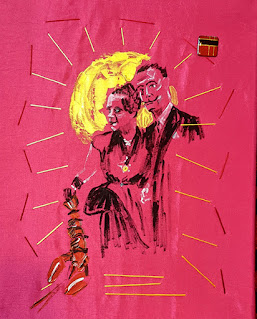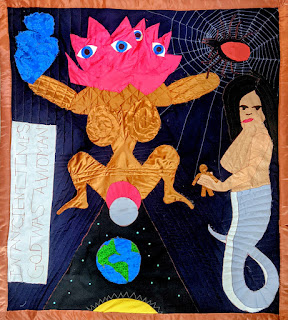The first piece I made was entitled "Salvador Dali Basking in the Glow of Elsa Schiaparelli". I still used a canvas and acrylic paint, but I covered the canvas with shocking pink fabric, featured my favorite historical fashion designer, and added a touch of embroidery and embellishment.
Elsa Schiaparelli was a fashion designer, possibly the most brilliant of all time, working in Paris at the same time as Coco Chanel. Their styles couldn't have been more different. Schiaparelli was a surrealist, as attested to by her collaborations with Salvador Dali. Together they made a lobster dress, worn by Wallis Simpson, the scandalous women who caused a King of England to abdicate the throne. Schiaparelli's motto was "Dare to be Different". She invented the color "Shocking Pink" with the help of a chemist and it became her signature. She pioneered sportswear for women, creating the first shorts, worn by a tennis star who shocked the world. Schiap, as she called herself, was truly amazing.
For my second submission, I decided to make my first quilt, inspired by my recent work researching and painting goddesses, and by a book I read 20 years ago or so, that had a profound impact on me. The book was The Alphabet vs. the Goddess by Leonard Shlain, and it was the first book I had read that looked critically at the roots of Abrahamic religions, and at the religions that had preceded these and were subsequently suppressed. Through this book and in later reading, I learned that the majority of ancient societies worshipped creator Goddesses. For the majority of human history, it was women who created the world. My quilt includes the Venus of Willendorf, Aditi in her form as Lajja Gauri, Nuwa, and Grandmother Spider.
There is a specific myth about Aditi birthing the 12 Adityas, each the sun for one month of the year. I show her birthing the sun, the earth, and the moon.
The next largest figure is Nuwa, a great mother goddess of Chinese mythology, credited with creating humanity. She molded the first people out of clay by hand. These became the nobility. Then she got tired, dipped a rope in the mud on the riverbank, and swung it around her head. The lumps that flew off the rope became the peasants.
In the corner is Grandmother Spider. She appears in the mythology of the Hopi, Navajo, and Cherokee peoples, among others. In various stories, she created people, sang them to life, led them out of the chaos of the underworld, stole a piece of the Sun and brought it to this side of the world, gave the world fire, taught the women to weave, and taught them how to create pottery. She is not the largest or the strongest, but she is the wisest.
I thought quilting would be a good choice of medium for a radically feminist message, as quilting is basically the epitome of feminine pastimes.
For my third piece, I was considering weaving a poem. It would be about goddesses involved with weaving. Frigg, spinning the wool of the cloud sheep. Ix Chel, weaving the the rainbow. The Norns and Fates, weaving our destinies. And then inspiration hit. I don't weave the Fates, the Fates weave me. I chose to make the Fates multicultural because so many different cultures have Goddesses of spinning, weaving, and fate. You can see how I feel about this possible lack of self determination.



Comments
Post a Comment